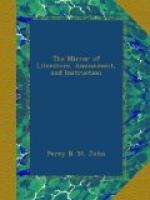“Another mode of sepulture which we saw here was, where the body of the deceased had been wrapped in birch rind, and with his property, placed on a sort of scaffold about four feet and a half from the ground. The scaffold was formed of four posts, about seven feet high, fixed perpendicularly in the ground, to sustain a kind of crib, five feet and a half in length, by four in breadth, with a floor made of small squared beams, laid close together horizontally, and on which the body and property rested.”
“A third mode was, when the body, bent together, and wrapped in birch rind, was enclosed in a kind of box, on the ground. The box was made of small squared posts, laid on each other horizontally, and notched at the corners, to make them meet close; it was about four feet by three, and two and a half feet deep, and well lined with birch rind, to exclude the weather from the inside. The body lay on its right side.”
“A fourth and the most common mode of burying among these people, has been, to wrap the body in birch rind, and cover it over with a heap of stones, on the surface of the earth, in some retired spot; sometimes the body, thus wrapped up, is put a foot or two under the surface, and the spot covered with stones; in one place, where the ground was sandy and soft, they appeared to have been buried deeper, and no stones placed over the graves.”
“These people appear to have always shewn great respect for their dead; and the most remarkable remains of them commonly observed by Europeans at the sea-coast, are their burying-places. These are at particular chosen spots; and it is well known that they have been in the habit of bringing their dead from a distance to them. With their women they bury only their clothes.”
“On the north-side of the lake, opposite the River Exploits, are the extremities of two deer fences, about half a mile apart, where they lead to the water. It is understood that they diverge many miles in north-westerly directions. The Red Indian makes these fences to lead and scare the deer to the lake, during the periodical migration of these animals; the Indians being stationed looking out, when the deer get into the water to swim across, the lake being narrow at this end, they attack and kill the animals with spears out of their canoes. In this way they secure their winter provisions before the severity of that season sets in.”
“There were other old remains of different kinds peculiar to these people met with about the lake.”




